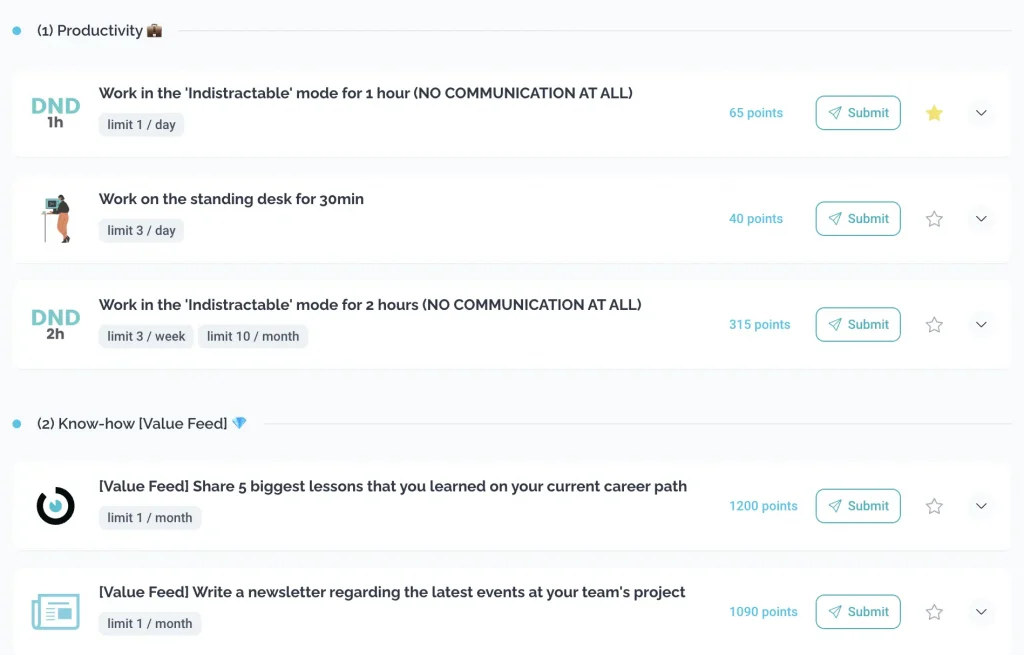Do you find it challenging to keep your employees motivated and engaged? Well, fear not because goals can be the answer to your problem! Setting inspirational and motivating goals for your team can unlock a new level of task performance and engagement in the workplace.
In this article, we will delve into the definition of goals and their impact on work, the significance of involving employees in defining common goals, and the role of goals in motivating employees. We will also discuss the concept of SMART goals and how to use them effectively to motivate your team towards success. So, to improve employee performance, engagement, or overall satisfaction, keep reading to discover the benefits of motivation through a conscious goal setting process.
Definition of Goals

The Importance of Goal Setting for Motivating Employees
Motivating team members to perform at their best is crucial to organizational success. Setting goals is one of the most effective ways to achieve this. Inspirational goals give a clear vision of what they need to accomplish, which helps them stay focused on employee engagement objectives. When employees understand what is expected of them, they tend to work harder and more efficiently to achieve their goals.
The definition of goals can be broadly categorised into short-term and long-term goals. Short-term goals can be completed within a few weeks or months, while long-term goals require more time and effort and can take years. Setting both types of goals can help motivate employees, as short-term goals provide them with a sense of accomplishment and progress, while long-term goals give them a feeling of purpose and direction.
Setting inspiring and challenging goals can be a double-edged sword. While it can motivate employees to perform at their best, unrealistic and unattainable goals can have negative effects on morale and productivity. Employees may feel frustrated and demotivated when they repeatedly fail to achieve their objectives, leading to burnout and disengagement. Therefore, it’s essential to strike a balance when setting goals and make sure they are challenging yet achievable. This requires managers to understand their employees’ capabilities and provide the necessary resources and support to help them succeed. By doing so, employees are more likely to stay motivated and engaged, leading to better performance and results for the company.
SMART goals

When motivating workers, setting clear and achievable goals is critical. This is where the SMART goals framework comes into play. SMART stands for Specific, Measurable, Attainable, Relevant, and Time-Bound.
Specific goals are clear and concise, leaving no room for interpretation. Measurable goals have a quantifiable outcome, making it easy to track progress. Attainable goals are realistic and achievable, ensuring employees don’t lose motivation to accomplish them due to unrealistic expectations. Relevant goals align with an employee’s job responsibilities and career development. Time-bound goals have a specific deadline, creating a sense of urgency and accountability.
How do goals affect work?

The Importance of Goals and Motivation in Work Life
Goals and motivation for target achievement are crucial in shaping and directing our work life. They act as a guiding force that helps us stay focused on our objectives and motivates us to do our best to accomplish them. Goals can have a significant impact on both employees and companies alike.
When companies set achievable and realistic goals for their employees, it helps them stay on track and ensures that their efforts align with the company’s vision and objectives. This, in turn, leads to better productivity and efficiency, which benefits the company as a whole. Likewise, when employees establish personal goals, it aids in maintaining their motivation while providing a sense of purpose and clear direction.

Benefits of Setting Achievable and Realistic Goals
Reaching personal goals can help employees develop their skills and grow in their careers. It also gives them a perception of accomplishment and satisfaction, boosting their morale and improving their overall performance at work.
When employees consistently reach their goals, it reflects positively on their performance and work ethics. This, in turn, can conduct salary increments and promotions, motivating employees to work harder and achieve even more. Moreover, achieving goals can also lead to salary rises and promotions. Setting achievable and realistic goals can thus pave the way for career growth and development.
How to involve employees in defining common goals?

Setting goals without involving employees in the process can be counterproductive. Employees need to feel that their opinions and contributions matter. When team members are involved in defining common goals, they feel ownership and are more committed to achieving them. It’s essential to create a collaborative environment where employees can share their ideas and concerns and contribute to the company’s overall success.
One way to involve workers in defining common goals is to conduct brainstorming sessions where everyone has an opportunity to contribute. It’s essential to ensure that all employees feel comfortable sharing their ideas and that their contributions are valued, regardless of their position within the company. Additionally, it is crucial to offer feedback and maintain open communication about progress to ensure that everyone is well-informed and aligned.
Another effective way to involve employees in defining common goals is to link individual goals to the overall company goals. When team members understand how their work motivation to reach goals directly impacts the company’s success, there is a higher probability that they will be invested in reaching their goals. It’s essential to provide regular feedback and recognize employees’ achievements to motivate the team to achieve common goals.
How Ogamify can help in achieving company goals?
Ogamify is a productivity tool that assists companies in boosting team engagement and integration by leveraging gamification mechanics. Its working mechanism is straightforward: select objectives and challenges for your team, and game elements will assist your employees in achieving them. Additionally, you could also use it to motivate employee performance through goal setting.
Just think about your company goals, and than split it’s realisation into small everyday tasks and challenges that will help your team to move towards them.


Dependence of motivation on the goal

Goals are an essential part of the work environment. They provide direction and purpose to our work and can significantly impact our motivation to achieve target levels. When we have a clear goal, we are much more likely to feel motivated to work towards it.
The reason for this is simple: goals give us something to strive for. They provide a feeling of accomplishment and satisfaction when we achieve them. Plans also help to break down larger projects into smaller, more manageable tasks. When we have a big project ahead of us, it can be overwhelming to think about all the work that needs to be done.
However, setting specific goals can make the project more manageable and less daunting. This can help increase employee motivation towards goals and make you feel more confident completing the project successfully.
Furthermore, goals help to provide a sense of focus and accountability. When we have a specific purpose, we are more likely to stay on track and avoid distractions. This can be particularly important in today’s fast-paced work environment, where distractions are everywhere. By focusing on our goals, we can prioritize our work and ensure that we are making progress towards achieving our objectives.
Conclusion

Goals are an effective tool for motivating workers and improving their performance. Employees can feel purpose and direction by setting clear, explicit, quantifiable, realistic, relevant, and time-bound goals. When they reach these goals, it can boost their confidence and motivation. The SMART goals framework is an effective tool for setting these goals.
Goals are crucial in shaping and directing our work life, providing a sense of direction and purpose, and motivating us to put in our best efforts to achieve them. Involving employees in goal-setting ensures their opinions and contributions are valued, and they feel ownership in achieving the goals.
It is also essential to link individual goals to the overall company goals. This can help employees understand how their work directly impacts the company’s success, leading to better productivity and efficiency.
Setting achievable and realistic employee engagement goals can pave the way for career growth and development, and when employees consistently reach their set goals, it can lead to salary increments and promotions, motivating employees to work harder and achieve even more. Motivation and goal setting are crucial aspects of improving employee performance in the workplace.
FAQ
Should goals be challenging or easily attainable?
Goals should strike a balance between being challenging yet achievable. Stretch goals that push employees beyond their comfort zones can inspire growth and motivation. However, goals that are too difficult or unrealistic can demotivate employees. It is important to set goals that are within reach but require effort and dedication to accomplish.
How often should goals be reviewed and updated?
Goals should be reviewed regularly to ensure their relevance and alignment with changing circumstances. Depending on the nature of the goals and the context of the work, goals can be reviewed monthly, quarterly, or annually. Regular check-ins and feedback sessions provide opportunities to assess progress, make adjustments, and set new goals if necessary.
Can employees set their own goals?
In some cases, employees can be involved in the goal-setting process, especially when it comes to individual performance goals. Allowing employees to contribute to setting their own goals enhances their sense of ownership and commitment. However, organizational goals and objectives should be cascaded from the top to ensure alignment and coherence.
What if employees encounter obstacles or setbacks in achieving their goals?
Obstacles and setbacks are common in any pursuit of goals. It is important for leaders to provide support, guidance, and resources to help employees overcome challenges. Encouragement, problem-solving assistance, and offering alternative strategies can help employees navigate obstacles and maintain motivation.
Can goals be adjusted or modified during the goal period?
Yes, goals can be adjusted or modified if circumstances change or new information becomes available. Flexibility in goal setting allows for adaptations that align with evolving business needs or individual circumstances. It is important to communicate any changes transparently and involve employees in the process to maintain motivation and commitment.


